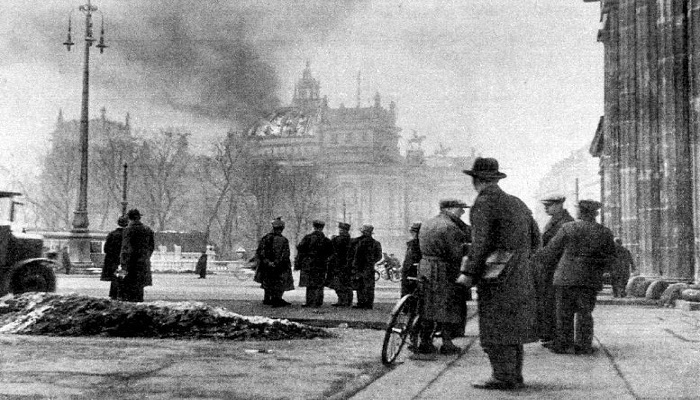Hitler became Chancellor of Germany in January of 1933, but he still had to answer to the president, Paul von Hindenburg, who ran for president to win against Hitler.
The Reichstag Fire
On February 27, 1933 the Reichstag went up in flames. When authorities arrived they found Dutchman Marinus van der Lubbe, who admitted to setting the fire. Police took him into custody and van der Lubbe was executed in 1934.
The fire destroyed most of the building, including the glass cupola that fell through the ceiling.
How Hitler consolidated his power
Hitler acted quickly and shrewdly the to gain undisputed power. A day later, he convinced Hindenburg that the fire was the beginning of a Communist revolution that needed to be put down as quickly as possible.
Hitler asked Hindenburg for temporary, emergency powers.
Hindenburg was 84, senile and most importantly, feared the rise of the Communists. He signed the Reichstag Fire Decree, which suspended all constitutional rights and extended the death penalty. People could be arrested, houses raided and weapons and material confiscated without any reason.
After receiving these powers, Hitler brought the state police under Nazi control with his secret police and militia. Members of the Social Democratic and Communist parties and any outspoken critics of the Nazis were rounded up quickly, sent to prisons, tortured or killed. Thus, Hitler essentially wiped out all political opposition.
Hitler then used the Reichstag Fire Decree to pass the Enabling Act of 1933, which allowed Hitler to make laws without Parliament or the President. This act marked the takeover of German democracy by Hitler’s dictatorship.
Mysteriousness of the fire
Still today, nobody knows who set the fire. It’s unlikely that Marinus van der Lubbe had actually set the fire. He was mentally ill and had a history of taking responsibility for crimes he didn’t do, particularly arson. In 1998 the German government even exonerated him. Even if van der Lubbe was involved, he couldn’t have acted alone. The fire was set in too many places at the same time for one person.
Some argue that the Nazis set the fire because Hitler was able to gain so much power so quickly from it. Others say the fire shows how cunning and ruthless Hitler could be. Hermann Göring, who later became the head of the Nazi Air Ministry, had an office that was connected with the Reichstag by a tunnel. After the blaze the rumor among many journalists was that the Nazis had used the tunnel to set the blaze. However, no evidence was ever found to support this theory.
The Reichstag’s return as symbol of democracy
Hitler shrewdly used the Reichstag fire to consolidate his power. The Reichstag, the symbol of German democracy, became meaningless, and Hitler never set foot in it again.
The building was further destroyed in WWII and was left unused by the West during Berlin’s division because of its close proximity to the wall.
It wasn’t until 1999 that the current German parliament moved into the building where they still are today.]








